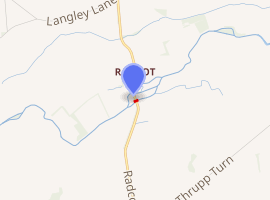Radcot Bridge
Radcot Bridge is a crossing of the River Thames in England, south of Radcot, Oxfordshire and not far north of Faringdon, Oxfordshire (formerly Berkshire). It carries the A4095 road across the river on the reach above Radcot Lock. Adjoining the bridge is the Swan Inn and slight earthworks of Matilda's Castle.
Radcot Bridge | |
|---|---|
Radcot Bridge | |
| Coordinates | 51.693081°N 1.588644°W |
| Carries | A4095 road, Thames Path |
| Crosses | River Thames |
| Locale | Radcot, Oxfordshire |
| Maintained by | Oxfordshire County Council |
| Heritage status | Grade I listed |
| Characteristics | |
| Design | arch |
| Material | stone |
| Height | 11 feet 4 inches (3.45 m) |
| Load limit | 18 tonnes (18 long tons; 20 short tons) |
| History | |
| Opened | circa 1200 |

| |
The bridges
There are in fact three stone bridges at this point on the Thames, from south to north: Radcot Bridge, the Canal Bridge and Pidnell Bridge. The first is nearest to Pidnell (a hamlet in Faringdon parish) and the last is nearest to Radcot. Whilst originally built on the Thames, Radcot Bridge is now on a backwater since the construction, in 1787, of a new cut for the Thames and Severn Canal. The Canal Bridge was built at the same time.
Radcot Bridge is often claimed as the "oldest bridge on the Thames", having been built, with pointed arches of Taynton stone, around 1200. The Cistercian monks of St Mary at Cîteaux in Normandy were granted land for the purpose by King John. Much of the structure was broken down during the battle which took place here in 19 December 1387 between troops loyal to Richard II, led by court favourite Robert de Vere, and an army captained by Henry Bolingbroke, Earl of Derby, (the future Henry IV). Radcot Bridge was reconstructed in 1393. The bridge was again severely damaged during the Wars of the Roses, and was largely rebuilt as it appears today, with a flattened centre arch.
Radcot Bridge became a toll bridge and its wharf was commercially important as the highest shipping point on the Thames, with the junction of the Severn-Thames canal not far away at Lechlade (Gloucestershire).
The Thames Path crosses the bridges.
Matilda's Castle
Time Team, in a programme first broadcast on 15 February 2009, excavated Matilda's Castle in the summer of 2008. They found that visible earthworks near the Radcot bridge dated from the 17th-century English Civil War, when Parliamentary forces built them to support cannon used to bombard Royalist forces garrisoned in Radcot House. Underneath some of these earthworks were remains of a square Norman keep dating from the time of the 12th-century Anarchy. Evidence suggested the tower was pulled down a century after it was built. Its remains were further damaged by later constructions on the site. Some Roman remains, possibly from a villa, were also found.[1]
See also
- Crossings of the River Thames
References
- "Time Team Radcot page". Channel 4. Retrieved 20 February 2009.
Further reading
- Toynbee, M.R. (1949). "Radcot Bridge and Newbridge" (PDF). Oxoniensia. Oxford Architectural and Historical Society. XIV: 46–52. Retrieved 27 October 2013.
External links
| Wikimedia Commons has media related to Radcot Bridge. |
- Faringdon Online: Radcot Bridge
- New Bridge — Oldest Bridge over the Thames, Vale and Downland Museum
| Next crossing upstream | River Thames | Next crossing downstream |
| Eaton Footbridge (pedestrian) | Radcot Bridge | Old Man's Bridge (pedestrian) |
| Next crossing upstream | Thames Path | Next crossing downstream |
| northern bank Bloomers Hole Footbridge |
Radcot Bridge | southern bank Tadpole Bridge |